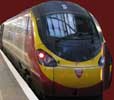Railway Companies using the Longsight Depot 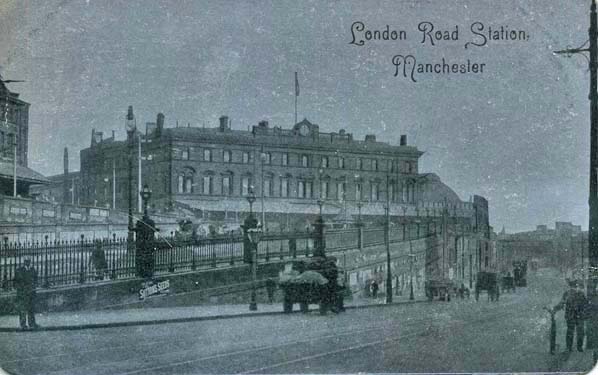 The Manchester & Birmingham Railway Company initiated the construction of a railway line from Manchester to Birmingham in 1836. The line sliced through Longsight west of Stockport Road and through a parcel of land that had been leased by John Jennison, the founder of Belle Vue. Jennison had purchased the land as a corridor from Stockport Road to his Zoological Gardens. The route of the track continued southwards and crossed Stockport Road and this time crossed land owned by the Siddall family of Slade Hall. When the first section of this line, from Manchester to Stockport, opened in 1840 the Longsight Station was located at the point where the line crossed Stockport Road. John Jennison was clearly very unhappy about the location of the station, so far from his gardens and in May of 1842, the railway company relented and relocated the station to the position it occupied until its closure next to Kirkmanshulme Lane, a short walk from Belle Vue. The whole length of the line from Manchester to Birmingham took 6 years to complete and it opened in July of 1842.
The London and North Western Railway was linked in 1840 with the Manchester-Birmingham Railway. By 1848, the Ordnace Survey map of Longsight indicates that the line which crossed the district was owned by The London and North Western Railway and in parenthesis Manchester, Birmingham, London. This conglomerate was made up of about a hundred companies. The London and North Western Railway's last acquisitions were the Lancashire and Yorkshire and North London Railways, taken over on the eve of the general amalgamation. By 1846 12 trains a day were running from Longsight into London Road Station, (now Piccadilly). Longsight Station became a major drop off point for visitors to Belle Vue and the railway company was running cheap trains for them. As Belle Vue's popularity grew an additional siding was laid out at the Longsight Depot to accommodate trains of 50 carriages.
Following the First World War many of the country's railway companies were looking bancruptcy in the face. The solution was amalgamation into a small number of large railway companies. Four large companies were created:
*"Of the four great railways formed in 1923 by the Railways Act of 1921, the London, Midland and Scottish was the largest. It was the only British railway serving England, Scotland, Wales and Ireland. Excluding the Irish Northern Counties Committee and certain joint lines, its route mileage was 6,758, and its total length, reduced to single track, was 18,921 miles. The L.M.S. was made up of seven constituent and twenty-seven subsidiary companies. The seven constituent companies absorbed in 1923 were the London and North Western, the Midland, the North Staffordshire, and the Furness Railways in England, and the Caledonian, Glasgow and South Western, and Highland Railways in Scotland. Many of these had already assimilated scores of smaller lines. Of the constituent companies the London and North Western, generally accorded the title of 'the premier line', was the largest with a route mileage of 1,807 in 1921. Of the four new companies the L.M.S. could claim other distinctions. It possessed the largest stock of locomotives, carriages and wagons. On January 1, 1934 it owned 8,004 locomotives, 24,023 coaching vehicles, 250 electric-motor vehicles, 22 steam rail-motors, 3 Diesel rail-cars, 270,441 merchandise and mineral vehicles, and 15,584 service vehicles. Under the last heading are included ballast wagons, coal and coke wagons for the use of the locomotive department, gas holder trucks, travelling cranes, tool vans, timber, rail, and sleeper trucks and breakdown cranes. In addition, the company owned 2,088 parcels and goods road motor vehicles, and over 8,400 horses. It possessed also 49 steamboats (4 jointly owned), 537 miles of canal, and docks, harbours and wharves, with a total length of approximately 93,000 ft. of quay. Of these Barrow, Grangemouth, Fleetwood, Holyhead, Heysham, Garston, Ayr, and Troon were the largest. Over 104 miles of track were electrified. The L.M.S. handled the largest passenger and goods traffic, and earned the largest income, its weekly traffic receipts averaged over £1,000,000. It owned numerous hotels, including some of the finest in the country. The L.M.S. re-organised the management of the companies into a single management structure which was a difficult, slow but ultimately rewarding process. The combined company was managed from London. The L.M.S. was a railway of contrasts, particularly in its secondary and branch-line trains which, compared with main-line services, were often slow and dirty. Strict economy spread to stations, which were infrequently cleaned, seldom painted, and bore a generally shabby appearance. Unlike the other companies there was no general reconstruction or modernization programme, and the only large station to be partly rebuilt was Leeds City." Until 1928, the different divisions of the company, primarily based on the constituent companies followed their traditions. Derby works, the Midland Railway's plant painted most of its locomotives in Crimson Lake, while the ex L.N.W.R. works at Crewe outshopped locos in black. After 1928, a standardised livery was adopted for locomotives. 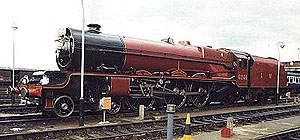  Mainline Locomotives --- Lined Crimson Red Mixed Traffic Locomotives --- Lined Black Freight Locomotives --- Plain black  British Rail
British Rail
 In 1948, the British
Government nationalized the four major railway
companies and created British Railways.
British Railways, or as it later became known
British Rail, consisted of all the railways in
Britain. This included many railway-operated ferry
routes, hotels and other businesses which railway
companies had operated until 1948. The company owned
all the track and operated all the trains. This
continued to be the situation until an Act of
Partliament in 1993 once again privatized Britain's
Railways.
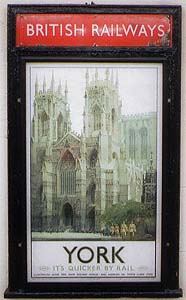 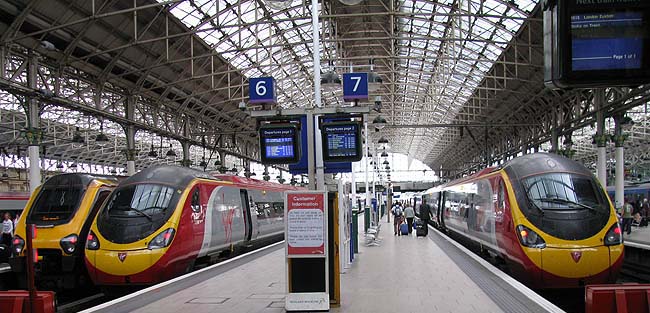 The Longsight rail yard is still
busy in the 21st Century but now Virgin Rail engines
and rolling stock can be found in the sheds.
Dwindling ridership resulted in the closure of
Longsight Station in 1958. The building survived for
a few more years but it is gone now too. The information about the London Midland Scottish Railway history came from Mike's Railway History Page. For a much more in depth account of the LMS please click on the link to go there. Some of the photographs on the Longsight Station site came from an excellent site that appears to no longer exist. It was called the "The Tony Dunkley Collection, A Railway Collection Containing 30 Years of Photographs". The site was maintained by John Daniel and contains a wonderful collection of photographs taken by his late friend Tony Dunkley. They are shown here with John's permission.
|


